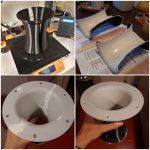A link regarding (industrial) resonance absorbers, as proposed at the beginning of this thread - helmholtz and quarter wave variants:
https://deicon.com/solutions/vibration-isolation/tuned-acoustic-absorbers/
I am currently "procrastinating" and doing a small research to underestand the transition from a helmholtz resonator to a quarter wave resonator.
I already had this in mind for some time and was reminded because of the apparent limits of bass reflex enclosures in case of big volumes and high outputs (see @tmuikku's subwoofer project). such speakers require very big ports for correct tuning and sensible compression/chuffing behaviour. The ports are huge, also related to the enclosure dimensions and clear distinction between "enclosure" and "port" is getting questionable.
I deliberately chose a small 4" driver to make the helmholtz resonance as independent from the driver as possible. at least in my understanding ...

some observations:

the big enclosure resonance peak is still more peaky.
the net enclosure is the same for all variants.
the port cross section surface and port lenght increase with every step, keeping the tuning the same.
use the arrow buttons to scroll through the variants (or swipe on the phone).

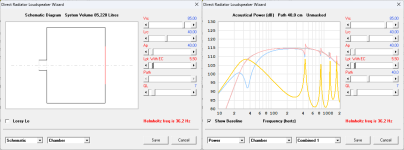

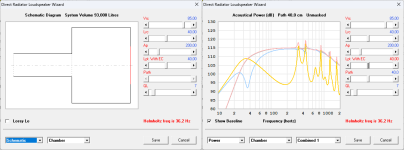
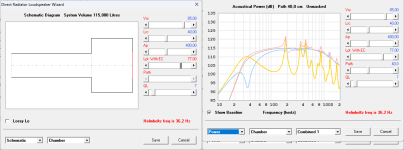
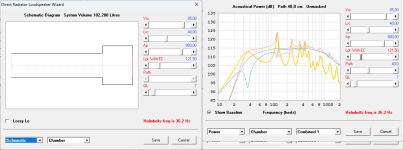
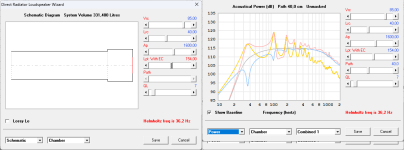
same simulation, but lossless, for caomparison to TL:
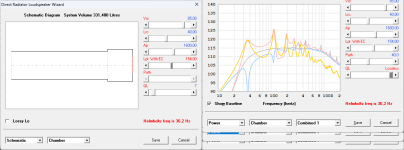
simulation of a simple transmission line with similar (same) dimensions.
the second transmission line section is slightly longer than the port to compensate for end correction of bass reflex port.
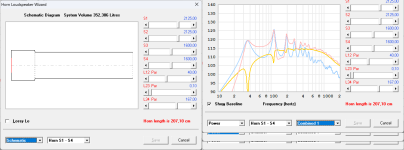
observations:
https://deicon.com/solutions/vibration-isolation/tuned-acoustic-absorbers/
I am currently "procrastinating" and doing a small research to underestand the transition from a helmholtz resonator to a quarter wave resonator.
I already had this in mind for some time and was reminded because of the apparent limits of bass reflex enclosures in case of big volumes and high outputs (see @tmuikku's subwoofer project). such speakers require very big ports for correct tuning and sensible compression/chuffing behaviour. The ports are huge, also related to the enclosure dimensions and clear distinction between "enclosure" and "port" is getting questionable.
1) hornresp simulation of different helmholtz resonators (bass reflex enclosures) tuned to 30 Hz
the variants have very different enclosure volumes and correspondingly different port lenghts.I deliberately chose a small 4" driver to make the helmholtz resonance as independent from the driver as possible. at least in my understanding ...
some observations:
- despite the same tuning frequency (according to hornresp loudspeaker wizard) the resonance peak frequency differs slightly.
- big enclosures with small ports have a more pronounced resonance peak
- the small enclosure big port variants have very strong and (obviously) lower frequency port resonance peaks.
2) small and big enclosure with similar peak frequency
to compare the small and big enclosure with similar peak frequency I adjusted the big enclosure tuning:the big enclosure resonance peak is still more peaky.
2) increasing the port size for a fixed enclosure and tuning
these are simulations of a PA woofer bass reflex enclosure (and one TL, for comparison).the net enclosure is the same for all variants.
the port cross section surface and port lenght increase with every step, keeping the tuning the same.
use the arrow buttons to scroll through the variants (or swipe on the phone).







same simulation, but lossless, for caomparison to TL:

simulation of a simple transmission line with similar (same) dimensions.
the second transmission line section is slightly longer than the port to compensate for end correction of bass reflex port.

observations:
- hornresp apparently does not allow making the bass reflex enclosure a "virtual transmission line" (it states the port is "too big"). thus the BR port and second TL section surface is "only" 1600 cm2.
- there seems to be a smooth transition between bass reflex enclosure (helmholtz resonator) and transmission line (quarter wave resonator). It seems impossible to draw an exact line where a bass reflex enclosure turns into a quarter wave resonator and vice versa. In other words it's a semantic rather than technical distinction.
- contrary to the simulation above the long port results in a more pronounced peak.
- obviously the big port or TL lead to strong resonances: first (desired) resonance at 1/4 wavelength and the second (unwanted) resonance at 3/4 WL.
Last edited:
It seems impossible to draw an exact line where a bass reflex enclosure turns into a quarter wave resonator and vice versa.
So I guess I'll have to correct my statement as per David B. Weems's definition!A BR turns into a TL when the port hits 72 inches or 6 feet.
So what is this then? I came up with this in 2009. It worked rather well. And essentially it is all port.
All TH's are all port.
The whole enclosure is a port.
TH's can have compression chambers like a FLH.




The whole enclosure is a port.
TH's can have compression chambers like a FLH.
It seems highly arbitary. As I do not prefer TLs (joking), I shall ensure all my ports do not exceed 71-15/16" in length. That last 1/16" ensures adequate tolerance.So I guess I'll have to correct my statement as per David B. Weems's definition!
Perhaps there's a little something lost in translation..?A BR turns into a TL when the port hits 72 inches or 6 feet.
David Weems says something interesting there, that there's a lack of precision in TL theory. That could indeed be said back when the book was written.
Doesn't a 6 foot horn equal a 40-45hz tune?
This is the SUBwoofer forum.
50hz BR/TL's are usually for full range bookshelf/tower speakers.
In this SUBwoofer forum, TL's SHOULD be for 28hz SUBwoofers (27.5hz is the lowest note of an 88 key piano for all you musical instrument purist).
30hz = SUBwoofer.
40hz = bass guitar bin.
50hz = kick drum bin.
But what do I know, I'm just a Hip Hop car audio basshead.
This is the SUBwoofer forum.
50hz BR/TL's are usually for full range bookshelf/tower speakers.
In this SUBwoofer forum, TL's SHOULD be for 28hz SUBwoofers (27.5hz is the lowest note of an 88 key piano for all you musical instrument purist).
30hz = SUBwoofer.
40hz = bass guitar bin.
50hz = kick drum bin.
But what do I know, I'm just a Hip Hop car audio basshead.
Not necessarily. Doesn't there have to be a primary modal reflection?Doesn't a 6 foot horn equal a 40-45hz tune?
I'm just talking basic 4pi, 2pi, 1pi, and 0.5pi models and measurements.
Room correction, DSP, PEQ, etc. should cover your primary modal reflections.

Room correction, DSP, PEQ, etc. should cover your primary modal reflections.
A folded pipe creates a box.
That's why a folded straight flare TL SHOULD perform equally to a BR with same volume and tune.
The difference between the 2 is the TL can be a positive (efficiency) or negative (small volume) flare enclosure.
Yeah, you can have a BR enclosure with a negative or positive flare port.
If I can get away with a wood thickness port, then why bother with a long port in general? I would want the simplest build possible. But, it's rare to see 6 piece (not including bracing) low tune BR's.
Now that I think about it, there is a TL thread on this forum where someone removed part of the line from inside the enclosure and the enclosure measured better as a regular BR enclosure.
I really liked the earlier post with the enclosure volume to port volume variations!
That's why a folded straight flare TL SHOULD perform equally to a BR with same volume and tune.
The difference between the 2 is the TL can be a positive (efficiency) or negative (small volume) flare enclosure.
Yeah, you can have a BR enclosure with a negative or positive flare port.
If I can get away with a wood thickness port, then why bother with a long port in general? I would want the simplest build possible. But, it's rare to see 6 piece (not including bracing) low tune BR's.
Now that I think about it, there is a TL thread on this forum where someone removed part of the line from inside the enclosure and the enclosure measured better as a regular BR enclosure.
I really liked the earlier post with the enclosure volume to port volume variations!
Just for the sake of precision this thread was deliberately created in the multiway forum, dealing with port resonances affecting midrange of (mainly) 2-way midwoofers.this SUBwoofer forum
Thanks! I think it's fine, unless there is need for further semantic discussion, deserving its own thread.@stv if you like, the off-topic can be split to it's own thread.
Or maybe a short pipe organ of limited musicality? 🙂A BR turns into a TL when the port hits 72 inches or 6 feet.
Yes, until it becomes a MLTL (which is kind of the point 😉 )A folded pipe creates a box.
Mr. Weems clearly says "when the line is long" and gives 6 feet as an example. I don't take this as any sort of definition, other than that as length increases, the thing is more likely to be a TL.Perhaps there's a little something lost in translation..?
David Weems says something interesting there, that there's a lack of precision in TL theory. That could indeed be said back when the book was written.
My fault! So use to seeing these TL discussions in the SUBwoofer forum.Just for the sake of precision this thread was deliberately created in the multiway forum, dealing with port resonances affecting midrange of (mainly) 2-way midwoofers.
Thanks! I think it's fine, unless there is need for further semantic discussion, deserving its own thread.
Mr. Weems clearly says "when the line is long" and gives 6 feet as an example. I don't take this as any sort of definition, other than that as length increases, the thing is more likely to be a TL.
So when does a BR turn into TL?
- Home
- Loudspeakers
- Multi-Way
- Investigating port resonance absorbers and port geometries
